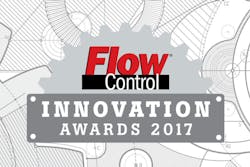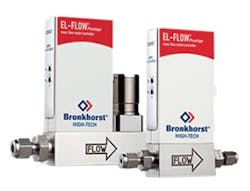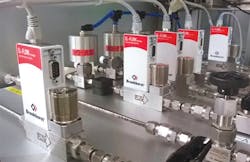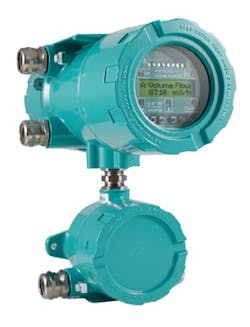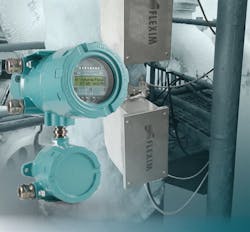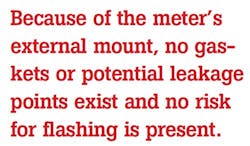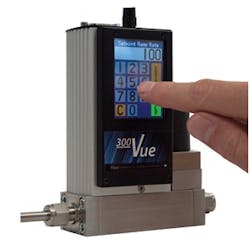For nearly two decades, Flow Control has honored the fluid handling industry’s ongoing commitment to manufacturing excellence through our annual Innovation Awards program. Each year, we are proud to present the latest innovations and technology breakthroughs in our industry based on an open nomination and reader voting process.
Thank you to everyone who participated in these awards by nominating or voting. Read about the featured technologies on the following pages. We hope to see your solution nominated next year.
Winner: Mass flowmeter for upstream oil and gas measurement — Fox Thermal Instruments Inc.
In the harsh North Dakota environment, the oil and gas Industry has found a new technology to use at upstream oil production sites in the Bakken: the Fox Model FT4A Thermal Gas Mass Flow Meter.
Production facilities in the Bakken Shale formation typically have a pipe running from the wellhead going to a vessel that separates the mixture of oil, water and gas pulled from deep underground. In normal operation, crude oil is distributed to a third-party oil gatherer, water is stored in tanks on-site or pipelined to saltwater disposals, and gas is delivered through a pipeline to a gas plant. When surplus gas is present that the pipeline cannot take, that gas is flared. In some instances, no pipeline is present and the gas must also be flared. Gas must be accurately measured for allocation purposes and for compliance with local and federal regulations of flaring or venting of gases.
Image Courtesy Of Fox Thermal Instruments Inc.
A large oil and gas company operating numerous production facilities across North Dakota reports that the Fox Model FT4A has been introduced into four key areas at its production facilities:
- Test vessels for allocation purposes
- Flare gas lines for waste gas or excess gas
- Flare gas lines from tank batteries
- Vent gas off of tank batteries
The Model FT4A was chosen for its robust DDC-Sensor and the oil and gas menu available on the Gas-SelectX feature.
The DDC-Sensor has a ¾-inch probe with non-cantilevered elements that have been welded at both ends for extra stability and strength. The strength of the DDC-Sensor is especially important in pipelines that are often littered with ice, mud, rocks, nuts or bolts leftover from construction that break loose and are propelled down the pipe at high velocity. These can break the tips off fragile probes or damage the sensing elements. The enhanced design of the DDC-Sensor also eliminates the sensor element vibration — found most often at high flow rates — which can potentially lead to metal fatigue and failure.
One of the biggest challenges to operating production facilities in the Bakken is measuring gas production accurately. Gas compositions tend to vary from well site to well site across North Dakota. A flowmeter used in this application must be calibrated to measure the specific gas mixture found at that site to ensure the highest level of accuracy. When facility supervisors need to order gas flowmeters for a new or existing well site, the Model FT4A can provide an easy solution for their needs. They can order the FT4A and program the gas composition into the meter to measure according to the reported gas sampling analysis for that particular site or from a neighboring site. Three gas menus are available on the FT4A Gas-SelectX feature with an extensive list of gases from which to choose. The Oil & Gas Menu is focused on common gases found at production facilities (see Table 1).
The customer can choose a pure gas or program any number of gases from the Mixed Gas or O&G Menus until a unique mixture is achieved.
The Model FT4A’s DDC-Sensor and the flexibility of Gas-SelectX to program a custom mix of gases are features that solve numerous problems (see Table 2).
Another advantage is that a backup FT4A can be quickly brought from one facility to another to replace a damaged flowmeter or a flowmeter in need of recalibration. Other flowmeters that require the meter to be returned for recalibration cause the production facility to be stuck without a measurement device for an extended time period. With the FT4A, no significant downtime exists when switching out the FT4A and setting the gas mixture right at the meter’s configuration panel.
Thanks to its robust DDC-Sensor design and innovative Gas-SelectX feature, the Model FT4A is making an impact in the gas measurement applications in the oil and gas industry.
For more information on Fox Thermal Instruments and the Model FT4A, visit foxthermalinstruments.com.
Honorable Mention: Exhaust gas simulation tests lambda probe with thermal mass flowmeters — Bronkhorst High-Tech
Each modern car with a combustion engine has a self-controlling way to optimize the engine performance. A lambda probe, a sensor positioned in the car’s exhaust system, measures the oxygen content of the car exhaust gases.
Testing of lambda probes
This oxygen content, the “lambda value,” is a measure for the effectiveness of the combustion process in a car’s engine. The lambda value is transferred to the car engine management system and, if necessary, the fuel/oxygen ratio to the engine is optimized by adjusting the fuel injection.
A research department of an automobile manufacturer needed to test the performance of these lambda probes with several exhaust gas compositions. To this end, they built an artificial exhaust line in which they did not use real exhaust gas, but simulated the composition of car exhaust gases. They asked Bronkhorst to deliver mass flowmeters for this purpose.
The auto manufacturer wanted the capability to change the composition from very low concentrations of gases like carbon monoxide (CO) and nitrogen oxide (NO), to very high concentrations. Furthermore, it wanted to change over quickly to another gas mixture.
Using thermal mass flowmeters/controllers
Bronkhorst provided multiple EL-FLOW Prestige thermal mass flow controllers for accurately supplying the components of the artificial exhaust gas composition to simulate a certain working point. Each specific mass flow controller was meant for a component that may be present in the car exhaust gas (N2, O2, CO, CO2, NO, hydrocarbons, sulfur compounds, etc.). These individually generated gas flows enter a mixing chamber and when the flow is stable, it is fed to the lambda probe. With the mass flow controller, it is possible to incorporate small amounts of gas into the artificial exhaust gas mixture. Several ranges were used, and the mass flow controllers were calibrated from 9 milliliters per minute to 20 liters (N2 gas) per minute.
To perform more lambda probe tests in the same amount of time, in a later stage Bronkhorst provided a second set of multiple EL-FLOW Prestige mass flow controllers to simulate another working point in parallel. While the lambda probe was tested using an artificial exhaust gas composition from the first train, the composition of the second train was premixed in the second mixing chamber. In this way, they could change over from one working point to another, physically disconnecting each of the mixing chambers to (from) the lambda probe and saving time.
EL-FLOW Prestige mass flow controller
This solution with the EL-FLOW Prestige mass flow controller was chosen because of the need for high flexibility and high accuracy. The setup had to be flexible since the real working points (compositions) have considerable variation. The EL-FLOW Prestige also helps future-proof the system if compositions or engine effectiveness change.
For more information on Bronkhorst and the EL-FLOW Prestige, visit bronkhorst.com.
Honorable Mention: Noninvasive flow measurement of cryogenic fluids — FLEXIM Americas Corp.
A major liquefied natural gas (LNG) terminal located in the Northeast U.S. has a storage capacity of 14.6 billion cubic feet (BCF) and a daily send-out capacity of 1.8 BCF.
Image Courtesy Of FLEXIM
The terminal is increasing the facility’s capacity to liquefy natural gas, which is done by cooling the gas until it becomes a liquid. The LNG is then loaded onto ships docked at the existing pier.
Traditional technologies for metering LNG have issues and challenges with the cryogenic application. This facility needed a cost-effective and accurate flowmeter that could measure LNG at a temperature of -250°F. It needed a meter that could be easily installed on existing pipes without having to stop processes.
The Venturi meters were often down or erratic because of pressure impact lines to the differential pressure transmitter freezing. Therefore, the facility needed a flowmeter that would require little to no maintenance, which would help save money and time as well as gather more accurate readings.
The solution for this LNG measurement application was the FLEXIM F704 with WaveInjectors. The WaveInjector has a Cryo Box that insulates the transducers and prevents ice buildup. FLEXIM is the only producer of extreme temperature, noninvasive ultrasonic flowmeter technology worldwide.
FLEXIM’s FLUXUS Cryo is engineered for extreme temperature applications from -310°F to 1,100°F. It covers applications from LNG to crude oil and hot acids.
The LNG terminal received many benefits from using the FLUXUS Cryo, including: extreme temperatures not affecting the external sensors, no pressure taps and freeze potentials, no pipe taps or spools, easy installation on existing piping, and properly insulated external sensors to provide maintenance-free operation. In addition, the transmitter consistently provides accurate and reliable readings, while also being maintenance-free, which saves the customer money and time.
FLEXIM’s FLUXUS Cryo provides a solution for all cases where reliable and trouble-free cryogenic flow measurement is required, such as LNG applications at carrier off-loading and ship-to-ship loading, flow measurement on floating storage regasification units as well as at peak shaving plants. Other cryogenic applications include flow measurement of media such as liquid ethane, liquid air, liquid nitrogen and liquid oxygen.
Independent of the pipe size – from 3-inch lines in peak shaving plants to 36-inch pipes for tanker off-loading to storage tanks – the system’s measuring accuracy and reliability meets all monitoring, control and safety instrumented system purposes.
Since the meter is mounted externally to the pipe, no moving or vibrating parts are present that could lead to increased maintenance efforts, no impulse lines are susceptible to freezing/blocking and no internal components exist that could cause pressure drops. Besides its high accuracy and reliability, FLUXUS Cryo features high operational safety: Because of the meter’s external mount, no gaskets or potential leakage points exist and no risk for flashing is present.
Moreover, the system is cost-effective. For installation, no pipework modification is needed and the system can be installed even with limited space conditions (e.g., floating LNG loading arms) with minimal effort and without the need for any lifting gear. Capital expenditure is further reduced because FLUXUS Cryo is flexible in regard to applicable pipe sizes, does not create inefficient pressure-losses and is virtually maintenance-free.
FLUXUS Cryo is based on FLEXIM’s patented WaveInjector technology for extreme temperatures, which is in use at thousands of measurement points at major oil and gas producers.
For more information on FLEXIM and the FLUXUS Cryo, visit flexim.com.
Honorable Mention: Digital thermal mass flowmeter measures for accuracy and repeatability — Teledyne Hastings
Image Courtesy Of Teledyne Hastings
An automotive research center has been performing work focused on engine exhaust. The flow control conditions are demanding. The application requires fast valve response to set-point commands while providing tight control of flow rates of more than 1,000 standard liters per minute. The user wanted a reliable, easy-to-use, high-flow capacity controller. The Teledyne Hastings 300 Vue Model HFC-D-307B with the color touch-screen display option was selected. The customer’s engineers utilized the digital communication capability so they would not have to process analog signals. Moreover, they did not have to worry about analog cable issues. The customer at the automotive research center connected the 300 Vue’s digital output to a PC and utilized Teledyne Hastings’ free data-logging software, which allows users to record flow conditions throughout the test duration. The engineers also wanted to see the flow rates though the experiment during live data runs. By using the 300 Vue’s local display, they did not need to purchase a separate display/readout.
Engine exhaust testing needs accurate and repeatable measurements. Although the 300 Series flow sensor has excellent linearity, linearization coefficients are measured and stored in the instrument during factory calibration, which is designed to give a superior accuracy performance: (±0.5 percent of reading + 0.2 percent of full scale). The researchers also utilized the auto-zero feature. When auto-zero is enabled and the instrument has the valve closed, the flow instrument will automatically rezero itself after a time.
The researchers selected the optional color touch-screen display, which allows users to easily view the flow rate. A set-point keypad provides a convenient method to enter flow commands. The display can be quickly changed between one of three modes. In the first mode, the user can observe the actual flow, the set-point and the full scale of the gas record in use. In the second, the user accesses the graphical mode, which shows live flow output versus time. Finally, totalizer mode allows simultaneous observation of gas that has been consumed and the flow rate. Moreover, the touch screen can be password-protected if required.
Accuracy, fast response and convenience made the 300 Vue the best choice for the application. The instrument solved challenges and was easy to install, easy to use, and made it easy to collect data and advance research.
For more information on Teledyne Hastings Instruments and the 300 Vue, visit teledynehastings.com.
